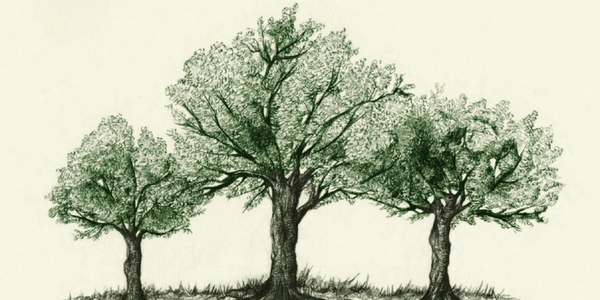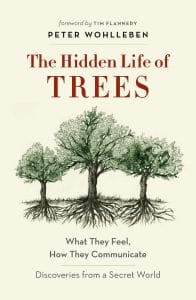The Hidden Life of Trees: What They Feel, How They Communicate, by Peter Wohlleben
David Suzuki Institute and Greystone Books Ltd., 9781-77164-248-4, 272 pp., 2015
Nature is a temple to many of us, and we may look at a stand of trees as nature’s cathedral, or a single tree as a much-beloved confidant or teacher. Our connection is spiritual and emotional, and we understand them intuitively. Yet there is another way of understanding trees — scientifically and physically — that can only add to their mystique and our deep love for them. The people who study trees this way have some amazing things to tell us.
Peter Wohlleben is one of these people. He is a forester who tends an environmentally friendly woodland in the Eifel mountains in Germany, following a 20-year career working in the German forestry service. He has used his specialized knowledge and day-to-day experiences and observations to write The Hidden Life of Trees, the tagline of which is “Discoveries from a Secret World.”
Secret, indeed — you need to look very closely to see what really goes on with trees. You need to look below the ground at roots (which interact using fungal, electrical, and chemical communication systems), at the way branches and leaves grow, and at how trees interact with animals around them. And you need to be patient, because this world of activity runs in what is to us slow motion. Any good secret is hidden well and takes effort to find, and so it is with trees.
Their root systems contain, perhaps, the most crucial secrets we need to uncover if we are to understand trees. Wohlleben tells us that tiny microscopic animals such as beetle mites, springtails, and pseudocentipedes, largely uninvestigated by researchers, form “the first link in the food chain and can, therefore, be considered terrestrial plankton.”1 Another secret just beginning to be studied is the “wood wide web” of soil fungi, one method trees use to communicate with each other.
These fungi operate like fiber-optic Internet cables. Their thin filaments penetrate the ground, weaving through it in almost unbelievable diversity. One teaspoon of forest soil contains many miles of these ‘hyphae.’ Over centuries, a single fungus can cover many square miles and network an entire forest. The fungal connections transmit signals from one tree to the next, helping the trees exchange news about insects, drought, and other dangers.2
So, although we perceive them as silent beings, they have a real physical “voice” — expressed in unseen electrical impulses, much like the neural and electrical networks in our own bodies. As fascinating as this is, it is far from the only secrets Wohlleben reveals in The Hidden Life of Trees.
Wohlleben breaks down his accumulated knowledge into 36 chapters, in between a foreword and two introductions (including one for the English edition) at the beginning, and a “Note from a Forest Scientist,” footnotes, and an index at the end. The book is suitable for casual reading by those who are fond of trees, or perhaps as a reference for a research paper by budding naturalists and biologists.
Each chapter stands alone and doesn’t depend on the one before or after it for background or context, so you can choose which topics you’d like to read about and skip over others. This certainly has its advantages, yet my Virgo Moon, craving organization, wished for some overarching sectional scheme to pull chapters of like topic together, i.e., root system, communications, feelings, tree etiquette.
This is only my own idiosyncrasy, and if you have a relationship with trees you’ll hardly notice, being swept up in their strange and beautiful world. I once heard the plant kingdom described as another form of intelligent life on our Earth, sharing our world at such a slow speed and in such a different language that we would have difficulty translating anything they tried to tell us, and vice versa. I think that’s probably as accurate a description as one could give, especially after reading the Hidden Life of Trees.
Wohlleben has given us a sort of Rosetta Stone for trees, and if future generations of naturalists and tree scientists continue to piece together their language, my hope is that we will learn from them how essential it is to take the long view in preserving our shared home.










